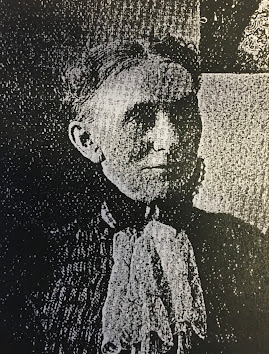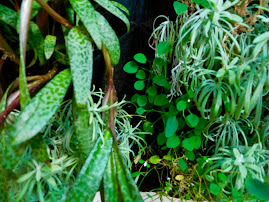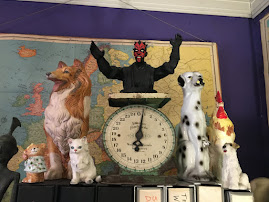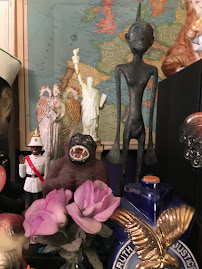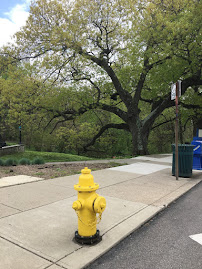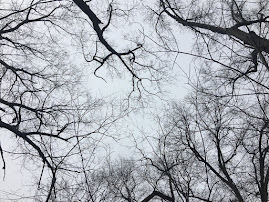Dear George,
Everyone is inundated with news about the coronavirus pandemic, and it sometimes seems like that’s all that we ever hear, think, or talk about. This is a switch from news about Trump although almost as depressing. Caught up in the new collective obsession, I decided to compile information from sources on the Internet and post some of it here in the form of questions and answers. These are either things that I didn’t know, thought I should remind myself about, and/or wanted to share with family and friends. Here are some of the things I found out.
Love,
Dave
Are “coronavirus” and “COVID-19” the same thing?
No, although the terms are often used interchangeably. The novel coronavirus (scientific name, SARS-CoV-2) is a virus named for the crown-like spikes on its surface. There have been six other coronaviruses known to infect humans in the past. Most have spread from animals to humans. COVID-19 is the disease caused by the novel coronavirus (its name derived from Coronavirus disease 2019). (cnn2) (note: letters in parentheses refer to sources at end)
How do COVID-19 and influenza differ?
COVID-19 kills more people. According to the CDEC, between 24,000 and 62,000 Americans died from the flu between Oct. 1 and Apr. 4 this past season. In contrast, over 87,600 people died from COVID19 between February and May 15. Coronavirus is twice as contagious as the flu, can spread unknowingly for many more days than the flu, more often results in severe illness, and, in contrast to the flu, there is no vaccine available. The number of reported deaths divided by the number of reported cases is 3-4% for COVID-19 (although the actual percent is lower because many cases go untested and unreported). Mortality for seasonal influence of the flu is usually well below 0.1%. (cnn2) (who)
Why do we have to shut down businesses for COVID-19 when we didn’t during the SARS and swine flu epidemics?
The novel coronavirus is different because it is both very contagious and far more lethal than the flu. SARS infected 8,000 people around the world, but caused only about 800 deaths. The swine flu infected 60 million people in the U.S. but with a very low fatality rate (1/3 as lethal as the flu). (wik)
How is COVID-19 transmitted?
Like the flu, COVID-19 can be spread from person to person through droplets in the air from an infected person coughing, sneezing, or talking. In addition, COVID-19 might be spread through the airborne route in which tiny droplets remaining in the air cause disease even after the ill person is no longer near. Recent research suggest that just breathing or talking may be enough to spread COVID-19. Airborne transmission of COVID-19 via small droplets is most likely in healthcare settings. (astho) (hop)
If they’re not coughing or sneezing, how can people infect others?
By speaking or by touching one’s mouth, nose, or eyes and then touching other surfaces. (cnn2)
How many people with COVID-19 show no symptoms?
CNN states that possibly up to 50% of infected people have no symptoms at all. One study reported in Science of coronavirus cases in China found that about 80% were infected by someone who didn’t know they had it. (cnn2)
How deadly is COVID-19?
Fatality rates vary widely, from 12% in Italy to less than 3% in the U.S. to less than 1% in Iceland. 80% of deaths have occurred to persons 60 years or older. The director of the National Institute of Allergy and Infectious Diseases estimates that the death rate is “about 2%.” (ast) (cnn2)
What states have had the most and least COVID-19 deaths?
According to the CDC (Center for Disease Control and Prevention) update on May 15, 2020, states with the most reported COVID-19 deaths were New York (22,707), New Jersey (7,237, Massachusetts (4,108), Michigan (3,361), Pennsylvania (2,819), Illinois (2,245), and California (1,904). States with the least COVID-19 deaths were Wyoming (7), Alaska (10), Hawaii (15), Montana (15), North Dakota (17), South Dakota (21), and Nebraska (42). The Upper Peninsula of Michigan has had 15 deaths, and Menominee County (Michigan) has had 8 cases and 0 deaths. (cdc)
Are non-medical masks effective?
According to the World Health Organization, evidence is limited and it’s unknown whether non-medical masks protect the wearer. However, they may protect others if the wearer is a pre-symptomatic or asymptomatic carrier of the virus. CNN suggests that masks won’t necessarily protect you because contaminated surfaces are a significant risk factor and infect those who touch those surfaces and later touch their eyes, nose, or mouth. (cnn2) (who)
Does the World Health Organization recommend the use of gloves?
No. WHO suggests that wearing gloves may increase risks since it can lead to self-infection or transition to others through touching contaminated surfaces which is not followed by removal of gloves and hand hygiene. Instead of gloves, WHO recommends public hand hygiene stations in stores and other locations. (who)
Is washing your hands with water as effective as washing with soap?
No. Washing with water alone doesn’t really help. You need soap or alcohol to dissolve the greasy liquid coating of the virus. (cnn2)
How do death rates from COVID-19 compare to other major diseases?
Compiling data from the CDC and other government sources, Business Insider concluded that deaths from COVID-19 recently surpassed past weekly averages for deaths from heart disease and cancer. From April 9 to 15, at least 13,613 people in the U.S. died from COVID-19, compared to weekly averages of 12,451 for heart disease and 11,521 from cancer. At the height of a recent flu season, 7,119 people died from the flu or pneumonia in a single week. (bus)
Why are older adults at greater risk?
People’s immune systems grow weaker as they age which makes it more difficult to fight off infectious diseases. And chronic health conditions like heart disease, cancer, hypertension, and diabetes, more common with age, can compromise the immune system. (nfid)
Why are rates of severe illness and death from COVID-19 higher among African-Americans and Hispanic-Americans?
The Association of State and Territorial Health Officials identifies numerous factors: densely populated housing, employment in essential or service industries, limited opportunities for working remotely, less access to paid sick leave, limited health insurance coverage, language barriers, and financial factors. (ast)
Will the COVID-19 outbreak stop during warm weather?
The CDC states: “It is not yet known whether weather and temperature affect the spread of COVID-109. Some other viruses, like those the cause the common cold and flu, spread more during cold weather months but that does not mean it is impossible to become sick with these viruses during other months.” The fact that the virus keeps spreading in the Southern Hemisphere during its summer months suggests it might not succumb to warmer temperatures. (cdc) (cnn2)
Can coronavirus live on clothes?
Available evidence suggests that the virus doesn’t survive as well on a soft surface (such as fabric) as it does on frequently touched hard surfaces (e.g., door handles). (hop)
Can the virus stay in a beard?
Coronavirus can stick to hair, and it is wise for beard-wearers to wash at least daily if not more often, depending on how often they touch their face. (cnn2)
Can people get COVID-19 from their pets?
According to the CDC, “At this time, there is no evidence that animals play a significant role in spreading the virus that causes COVID-19.” Pets can have a variety of canine and feline coronaviruses that can make them sick, and a small number have been reported to be infected with the COVID-19 virus, mostly after contact with people with the illness. The CDC recommends not letting other people pet your dog when out on a walk. (cdc)
Is one immune to COVID-19 if they have had the disease and recovered from it?
Health experts don’t yet know the answer to this. Scientists are currently investigating this question, and it is unclear to date whether one can become re-infected. (cdc)
When can we go to the symphony or to the pro tennis tournament?
The Association of State and Territorial Health Officials concludes that a return to everyday life is unlikely until the coronavirus is controlled through vaccines, preventive medicines, treatments, and widespread testing. “Experts are uncertain as to when it would be safe to allow large gathering and crowds…without careful social distancing.” (ast)
Is a vaccine in the offing?
Most experts say that the virus won’t stop spreading until 60-70% of the population is immune. Vaccines are the only way to reach that level without a monumental death toll. According to experts cited by NBC News, the National Institutes of Health is planning to begin large-scale testing of several promising vaccine candidates this summer. However, developing, testing, and production of vaccine for the public is still at least 12 to 18 months away. Most vaccines take 10-15 years to develop, and the fastest vaccine on record, the mumps vaccine, took four years. The longer we go without a vaccine, the more likely that focus will shift toward therapeutic drug treatments.
(cne) (nbc)
Could herd immunity eventually prevent COVID-19?
Herd immunity happens when so many people in a community or society become immune that it stops the disease from spreading, either through vaccination or through contracting the disease and building up natural immunity. For most diseases, 80- to 95 percent of the population must be immune to the disease to stop its spread. In the U.S. this would mean up to 3 million deaths in the absence of an effective vaccine. Healthline.com concludes: “Herd immunity isn’t the answer to stopping the spread of SARS-CoV-2.” (atl) (hea)
SOURCES:
(acl) acl.gov, “Coronavirus Disease 2019 (COVID-19)”;
(ama) ama-assn.org, “COVID-19: Frequently asked questions” (Apr. 30, 2020);
(ast) astho.org, “COVID-19: Simple Answers to Top Questions” (Association of State and Territorial Health Officials);
(atl) the atlantic.com, “No Testing, No Treatment, No Herd Immunity, No Easy Way Out” (Yascha Mounk, Apr. 28, 2020);
(bus) businessinsider.com, “One chart shows how many Americans are dying from the coronavirus…” (Apr. 17, 2020).
(cdc) cdc.gov, “Coronavirus Disease 2019 (COVID-19); ADD DATES FOR BELOW IF AVAILABLE
(cin) cincinnati.com, “Simply talking in confined spaces may spread the coronavirus” (USA Today, May 13, 2020);
(cnn) cnn.com, “Men in low-skilled jobs are dying from coronavirus at a higher rate…” (May 11, 2020);
(cnn2) cnn.com, “You asked, we’re answering: Your top coronavirus questions”;
(fda) fda.gov, “Coronavirus Disease 22019: Frequently Asked Questions” (U.S. Food and Drug Administration);
(hea) healthline.com, “What Is Herd Immunity and Could It Help Prevent COvID-19?”;
(nfid) noid.org, “Common Questions and Answers About COVID-19 for Older Adults” (National Foundation for Infectious Diseases);
(sta) statista.com, “Number of COVID-19 deaths worldwide by country”;
(who) who.int, “Q&A on coronaviruses (COVID-19)” (World Health Organization);



















